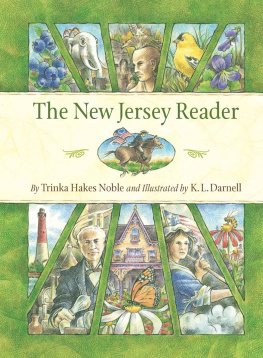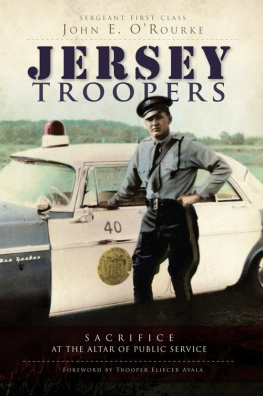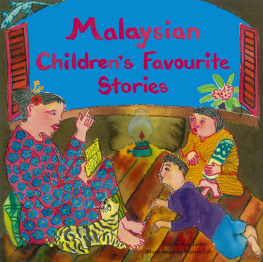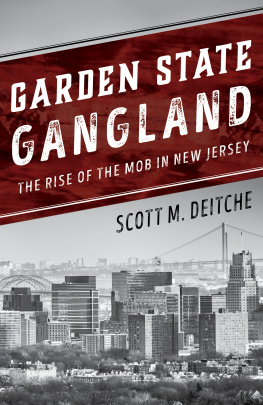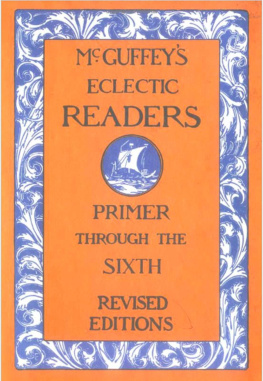Table of Contents
Guide
Text Copyright 2009 Trinka Hakes Noble
Illustration Copyright 2009 K. L. Darnell
All rights reserved. No part of this book may be reproduced in any manner
without the express written consent of the publisher, except in the case of brief
excerpts in critical reviews and articles. All inquiries should be addressed to:
Sleeping Bear Press
2395 South Huron Parkway, Ste. 200
Ann Arbor, MI 48104
www.sleepingbearpress.com
Printed and bound in the United States.
10 9 8 7 6 5 4 3 2
Library of Congress Cataloging-in-Publication Data
Noble, Trinka Hakes.
The New Jersey reader / written by Trinka Hakes Noble ;
illustrated by K. L. Darnell.
p. cm.
Summary: This primer is modeled after the McGuffey Readers of the
19th century. Contents include a New Jersey pledge, the Lenape history,
a four season poem, a Molly Pitcher story, a play set during the Civil
War, and a New Jersey timelineProvided by publisher.
ISBN 978-1-58536-438-1
1. New JerseyLiterary collections. 2. Readers (Primary)
I.Darnell, Kathryn, ill. II. Title.
PS548.N5N63 2009
810.80358749dc22 2008040747
Preface
New Jersey has always placed great importance on education and learning. The earliest schools were started by the Dutch and Swedish colonists, with records dating back to 1664 . The early Quaker settlers believed in education and had schools for all children. New Jersey was the only colony to have two universities. In Bordentown, Clara Barton taught without pay to help successfully establish New Jerseys first free public school. Today over % of New Jerseys high school graduates go on to higher learning, the highest in the nation.
The New Jersey Reader is written in the spirit of this long heritage of learning. Patterned after early school primers, it is filled with stories, poems, riddles, nonfiction, drawings, and even a play and timeline, too. I hope you enjoy reading about the state of New Jersey and share this small book with family, friends, and classmates.
Your friend,
Trinka Hakes Noble
For all the wonderful children of New Jersey
T. H. N.
To young artists everywhere, who use their imaginations
to express both what they see and what they hope.
K. L. D.
Table of Contents
A New Jersey Pledge
Once the ancient land of the Lenni-Lenape,
the Revolutions Crossroads became our destiny.
Sitting in the middle, this little colony
forged the link so our country could be free.
With more battles fought for our liberty,
we became our nations state number three.
Small yet powerful, we pledge our hearts to thee!
This place we call home, the state of New Jersey!
Land of the Lenape
L
ong ago, New Jersey was part of an ancient land called Lenapehoking , which means Land of the Lenape. For twelve thousand years the Lenape lived peacefully in small villages along its many rivers and streams. Lenape means the common people. Sometimes they are called the Lenni-Lenape, which loosely translates We the people. Now they are called the Delaware for the Delaware River which runs through the heart of their ancestral homeland.
The Lenape were divided into several areas. Those north of the Raritan River, including ________
the Delaware Water Gap, were the Munsee, or people from Minisink, the stony place. Those south of the Raritan were called the Unami, or the downriver people. Further south, along the Atlantic Coast and Delaware Bay, were the Unalachtigo, or people near the ocean. The Delaware River connected all three groups.
The Lenape built dugout canoes from the trunks of tulip and elm trees for travel and trade. Some were large enough to carry people and were used in the bays and along the Atlantic Coast. There were also many woodland pathways that crisscrossed the for- est floor and connected the villages. Some main trails, like the Minisink Trail, led from the mountains down to the shore where the Lenape would gather each summer to collect clams, oysters, and scallops. Then they made beads and wampum from the shells.
Lenape houses were round or oblong, made of sapling poles and covered with bark and woven mats. There was a smoke hole left in the top and the door faced east to greet the rising sun. Everyone worked hard. Men and older boys did the hunting, fishing, and heavy work. Women and children tended gardens, gathered wild berries and nuts, and prepared the food and clothing.
The Lenape were a peaceful nation. When disputes broke out between other East Coast tribes, the Lenape were called in to settle the matter. All Lenape people had a right to speak and each tribe had a wise leader called a sachem .
Starting in 1620 Europeans came and settled on Lenape land, often without permission. They brought diseases like measles, smallpox, and mumps, which decimated many Lenape people because they had no natural immunity. Most of the Lenape had disappeared by 1735.
But they left behind many names as a remind- er of their long existence. In their language, Hoboken means tobacco pipe, Absecon means place of the white swan, Watchung means hilly place, Manasquan means place to gather grass, and Allamuchy means place of the cocoons.
Yet there are descendants of the Lenape still living in New Jersey today. Just as the Lenape of old, they are determined to pass on their respect and love of the land. We can learn much from their wise council.
Hidden Symbols of New Jersey
State Animal (Horse)
State Insect (Honeybee)
Football (first game played)
State Tree (Red Oak)
Soup Can
State Bird (Goldfinch)
Lightbulb
State Flower (Violet)
Salt Water Taffy
Lighthouse
Beach Umbrella
The Garden State
N
ew Jersey is nicknamed the Garden State. The first time New Jersey was called the Garden State was in 1684 . A Scottish news- paper printed an advertisement seeking settlers for the new colony of New Jersey. In the ad they called it the Garden State. The nickname remains to this day and for good reason.
New Jersey is favored with a moderate climate. The winters were not as harsh as New England and the summers were not as hot as the southern colonies. The soil between the Hudson and the Delaware rivers was rich, perfect for farming, especially in the southern ________
Delaware River region. The Passaic, Raritan, and Hackensack rivers had rich valleys, too. Here, as early as 1630 , the Dutch settled and began to farm. They learned how to grow native plants from the local Lenape tribes, and shipped their produce to market on these rivers. Other European settlers soon followed and began to farm.
In 1861 Vineland was created to attract immi- grants from Italy who were excellent farmers. Their knowledge and care enriched the sandy ________
soil to produce many thriving fruit orchards, vineyards, and vegetable farms. Cranberries also thrive in bogs in this southern region. In fact, New Jersey is one of the leading growers of cranberries, which are native to our country.
New Jersey is also a leading producer of blueberries, grapes, freestone peaches, egg- plants, asparagus, pumpkins, tomatoes, and sweet corn. Over different kinds of fruits and vegetables, as well as many fresh flowers, are cultivated here. Many of these well-known varieties were developed at Rutgers University.
Summer and fall are very bountiful seasons with farmers markets and roadside stands filled with Jersey Fresh produce. Even though we are the most densely populated state in the United States, New Jersey can still be called the Garden State.

